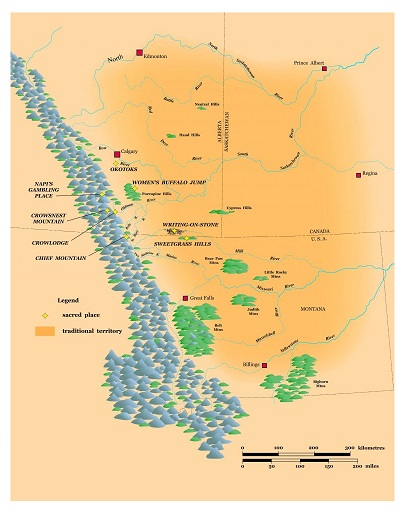The Niitsítapi (Blackfoot), also known as the Blackfoot Confederacy, are a confederacy of nations comprised of the Amsskapipiikunniwa (Blackfeet Tribe) located in northern Montana, Kainaiwa (Blood Tribe), Siksikawa (Siksika Nation) and Aapatohipiikunniwa (Piikani Nation), located in southern Alberta, Canada. Niitsítapi traditional territory spans roughly, the Southern half of Alberta and Saskatchewan from the Rocky Mountains to the Plains, as well as a Northern portion of Montana.

Glenbow Museum Alberta
The Niitsítapi are a Plains orientated Indigenous people whose culture was originally tied to the Bison hunt; while following Bison populations, other supplemental foods included deer and other large game, nuts, fruits, and vegetables. Important cultural sites for the Niitsítapi which demarcate traditional territory are, as indicated by the Blackfoot Confederacy: Ninastako (Chief Mountain), Iini Ksiskom (Buffalo Springs), Moko’ waansin (Belly Buttes), Soyioh’powah’ko (Blackfoot Crossing), Miistuki’sts Koowa (Castle Mountain), Aiyii Ki’mikoi (Cypress Hills), Hand Hills, Old Man River, Yellowstone River, North Saskatchewan River, Table Mountain, Crows Creek, Sand Hills, Big Horn Medicine, Sweet Pine Hills, Kai’skah’piiks (Porcupine Hills), Table Mountain, Oiskit’tsi’poi’iystuki (Heart Butte Mountain), and Whale Back Ridge.
The Niitsítapi (Kainai, Siksika and Apatohsipiikani) are signatories of Treaty 7, September 22, 1877 and current federally allocated Blackfoot territory is found in Alberta and Montana; much traditional Blackfoot territory in Saskatchewan has since been settled and is covered under Treaties 2, 4, and 6 of which the Blackfoot are not signatories. This represents a major loss of ancestral land and resources for the Blackfoot. After 1812, the insertion of the 49th parallel (Canada and U.S. Border) divided the Piikani tribe into the Ampskapi Pikuni in Montana and the Apatosi Pikuni in Southern Alberta.
Niitsítapi governing structures were non-hierarchal in nature and decision-making processes were shared among the group. Consensus was made by leaders chosen for their unique and valued skills, who represented 15 other members from Niitsítapi communities. One-way leadership was proven through one’s capacity and ability to care and nurture others, particularly the young and elderly. 36 clans from 3 different tribes comprised the Nation, and were responsible for maintaining and protecting the territorial boundaries. Along with their powerful confederacy, the Niitsítapi formed alliances with other Athabaskan nations such as the Tsuut’ina, as well as the Algonquian-speaking A'aninin with whom they traded, formed relationships with, and protected boundaries.
During the summer, groups would converge to hunt bison, and celebrate with elaborate feasts and dances. The Sun Dance, a communal celebration held annually in mid-summer, was the central aspect of Blackfoot cultural life. European settlers and missionaries opposed the Blackfoot’s complex and well established traditions. Assimilatory laws and policies were implemented in order to eradicate the expression of traditional culture (See also Indian Act and Residential Schools.) However, Blackfoot oral histories passed cultural traditions on to future generations, including participating in sweat lodges and sacred societies (such as the Horn Society), using medicine bundles, and other means of purifying the body and soul.” - Dempsey, Hugh A., Zach Parrott, and Michelle Filice. Blackfoot Confederacy. Canadian Encyclopedia. 2019.
The food shortage on the Plains and a growing issue of horse raiding brought the Niitsítapi into an increased number of conflicts with the Cree-Nakoda alliance. In 1871, a peace treaty brought an end to the long running war between the Niitsítapi and the Cree. This was also known as the Assiniboine alliance. The roots of this conflict can be traced back to the height of the fur trade and competition over the dwindling bison herds. In the fall of 1870, the Niitsítapi won a crucial victory over 600-800 Cree, Nakoda, and Saulteaux warriors in a battle at Belly River (near present day Lethbridge, AB). Following the Niitsítapi victory all sides acknowledged the futility of inter-Nation warfare, especially with the increasingly chaotic 'Whoop-Up' trade moving northward from America, and agreed to a peace treaty to end hostilities. Please note that this warfare was just one moment in the long history of the Niitsítapi Nation, through which there were many times of peace and neutrality as well - this is evident in the Peace Treaty which the Nations formed in 1871. This also demonstrates that First Nations have always had protocols of addressing conflict, even serious conflict, to come to legally, socially, and politically recognized decisions.
Today, membership of the Blackfoot Confederacy is roughly 22,000 in Canada, and 45 000 members across North America.
Resources:
-
The Blackfoot Confederacy. "About Siksikaitsitapi – Blackfoot Confederacy Tribal Council." 2021. https://blackfootconfederacy.ca/about/
-
Dempsey, Hugh A., Zach Parrott, and Michelle Filice. Blackfoot Confederacy. English ed. Toronto: Historica Canada, 2019
-
Gladstone, Joseph Scott, and Pepion, Donald D. "Exploring Traditional Indigenous Leadership Concepts: A Spiritual Foundation for Blackfeet Leadership." Leadership (London, England) 13, no. 5 (2017).
-
Glenbow Museum, Niitsitapiisini: Our Way of Life Exhibit, https://www.glenbow.org/blackfoot/
